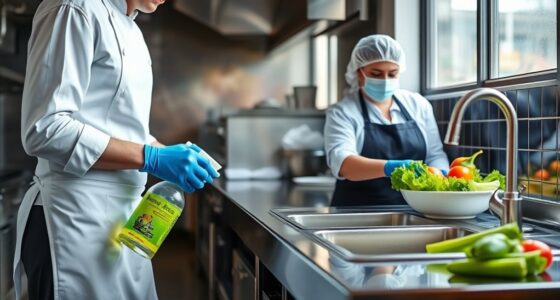TCS (Time and Temperature Control for Safety) foods are perishable items like meats, dairy, and cooked vegetables that need proper handling to prevent foodborne illness. You must keep these foods at safe temperatures—41°F or lower in the fridge, 135°F or higher when hot, and reheat to 165°F. Bacteria grow rapidly between 41°F and 135°F, so controlling time and temperature is key. To stay safe, you’ll want to follow best practices and stay informed about proper procedures.
Key Takeaways
- TCS foods require strict time and temperature controls to prevent bacterial growth and foodborne illnesses.
- Keep TCS foods at 41°F (5°C) or lower, or 135°F (57°C) or higher, to stay out of the danger zone.
- The danger zone (41°F–135°F) promotes rapid bacteria doubling; proper control limits bacterial growth.
- Use reliable thermometers to monitor and maintain safe temperatures during storage and holding.
- Discard foods that have been in the danger zone too long or fall outside safe temperature ranges.

Have you ever wondered which foods require special handling to prevent foodborne illness? If so, understanding how to manage TCS foods—those time and temperature control for safety foods—is essential. These foods are particularly vulnerable because they provide an ideal environment for bacteria to grow when not stored or handled properly. To keep yourself and others safe, you need to pay close attention to storage safety and temperature guidelines.
First, proper storage safety is critical. You should always keep TCS foods at the correct temperatures to slow down bacterial growth. This means storing perishable items in refrigeration units that maintain temperatures at 41°F (5°C) or lower. Cold storage keeps bacteria from multiplying rapidly and reduces the risk of contamination. When storing foods, organize your fridge so raw meats, seafood, and poultry are on the bottom shelf to prevent drips onto other foods. Keep ready-to-eat foods separate from raw items to avoid cross-contamination. For hot foods, use hot-holding units that maintain temperatures at 135°F (57°C) or higher. These units prevent bacteria from growing on cooked items that need to stay warm before serving. Proper storage safety isn’t just about temperature; it also involves keeping foods covered and properly labeled, so you know how long they’ve been stored. Regularly check storage temperatures with a thermometer to ensure they stay within safe ranges. Additionally, understanding the danger zone temperature range helps you better manage TCS foods and prevent bacterial growth. Remember, even a small lapse in storage safety can lead to bacteria multiplying rapidly, increasing the risk of foodborne illness.
Temperature guidelines are the backbone of controlling TCS foods. You should always monitor the temperature of foods from the moment they’re prepared until they’re served or discarded. For refrigeration, keep TCS foods at 41°F (5°C) or lower, and be vigilant to prevent temperature fluctuations. When reheating cooked foods, ensure they reach an internal temperature of at least 165°F (74°C) to kill any bacteria that might have grown. Hot foods should be held at 135°F (57°C) or higher until served. Use a reliable thermometer to check these temperatures regularly, especially during busy periods. If a food item falls outside these temperature ranges, it should be discarded to prevent potential illness. Remember, bacteria can double rapidly between 41°F and 135°F, so keeping foods out of this “danger zone” is crucial. Proper temperature control is not just about following rules; it’s about protecting your customers and yourself from illnesses caused by improperly handled foods.
Frequently Asked Questions
How Can I Identify TCS Foods in My Kitchen?
You can identify TCS foods in your kitchen by checking for items that require strict food safety measures, such as dairy, meats, seafood, and cooked vegetables. These foods are perishable and need proper temperature control. Keep an eye on their storage conditions and labeling. Effective kitchen management involves regularly monitoring these foods to prevent spoilage and make certain of safety, reducing the risk of foodborne illnesses.
Are There Specific Storage Guidelines for TCS Foods?
You should follow specific storage guidelines for TCS foods to guarantee safety. Keep them at proper temperatures—refrigerate perishable items below 41°F and freeze frozen foods at 0°F or lower. Store TCS foods separately from raw meats and chemicals to prevent cross-contamination. Always label and date these foods, and adhere to safety protocols like regular temperature checks. Proper storage minimizes bacterial growth and keeps your kitchen safe for everyone.
What Are the Risks of Improper TCS Food Handling?
Imagine a ticking time bomb—improper handling of TCS foods can lead to cross-contamination hazards and spoilage. If you don’t follow proper procedures, bacteria multiply rapidly, increasing foodborne illness risks. Spoilage detection methods, like noticing off-odors or slimy textures, are vital for safety. Without careful handling, you risk serving unsafe food, endangering customers and damaging your reputation. Always prioritize proper storage, temperature control, and thorough hygiene practices.
How Often Should TCS Foods Be Monitored for Temperature?
You should monitor TCS foods’ temperature at least every four hours to guarantee safety. Regular temperature checks help you catch any deviations from safe ranges promptly. During busy periods, increase monitoring frequency to every two hours if possible. Consistent monitoring allows you to maintain proper temperature control, preventing bacterial growth and foodborne illnesses. Always document your temperature checks to stay compliant and ensure safe food handling practices.
What Equipment Is Best for Controlling TCS Food Temperatures?
Like Da Vinci’s precision, choose refrigeration units with built-in temperature sensors to keep TCS foods safe. These units maintain consistent temperatures, preventing bacterial growth. Look for commercial-grade refrigerators or freezers with accurate, easy-to-read gauges. Regularly calibrate temperature sensors to guarantee reliability. Investing in high-quality equipment helps you control TCS food temperatures effectively, ensuring safety and compliance while reducing waste and spoilage.
Conclusion
Understanding TCS foods and proper time and temperature control is essential for food safety. Did you know that improper handling of TCS foods causes nearly 90% of foodborne illnesses? By following safe practices, you can prevent contamination and protect your customers. Remember, keeping hot foods hot and cold foods cold isn’t just a recommendation—it’s a must. Stay vigilant, control time and temperature, and help make every meal safe and enjoyable.









